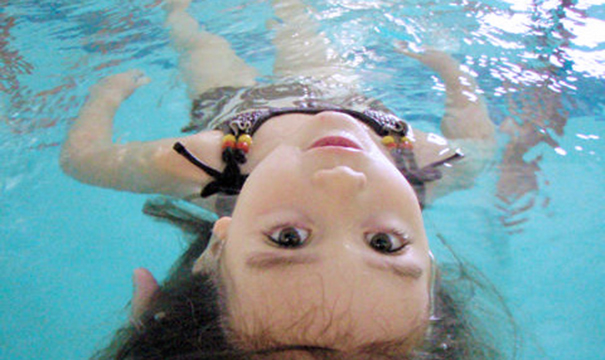
Swimming in a pool is great for your body, but hard on your hair!
Frequent swimmers are prime candidates for the frazzled look of Swimmer’s Hair. Unfortunately, it is more than a “look.” Swimmer’s Hair is dry and damaged by chemicals used to keep the water safe for swimming.
Isn’t it amazing that exposure to water can make hair dry and damaged?
Well actually – the water isn’t what causes the problem. It is actually what is in the water: The pool chemicals (especially bromine and chlorine). These chemicals react with the sebum and oils that protect your hair to leave your hair’s cuticle exposed. That sounds pretty scientific because it is. The damaged is caused from a series of chemical reactions.
Stripping hair of its natural protecting oils also makes it more susceptible to damage from the sun’s ultraviolet rays. These rays break the bonds in keratin (the protein that makes up hair) and cause brittleness and split ends. The pigment molecules in hair also succumb to pool chemicals and the sun, allowing it to become lighter and faded looking.
Starting Out with Healthy Hair
Healthy hair is less susceptible to swimmer’s hair than hair that already has damage. If you have colored, permed or heat-treated hair, your hair is at greater risk for dryness and color loss from swimming than it would be if you had untreated hair. If you swim a lot, try to minimize hair processing and keep up your cut so that chlorine won’t get in through split ends.
Steps to Protect and Heal Hair
There are a few steps that you can take to protect your hair from a case of Swimmer’s Hair:
1. Wet your hair before going into the swimming pool. Soak your hair in the shower or in tap water before entering the pool. Hair that is already saturated with water is less likely to absorb the swimming pool chemicals.
2. Tie hair up. If your hair is long enough, pull it into a ponytail on top of your head and secure the ends under the rubber band. Unless you are going to submerge your head in the water, this helps to keep most of the hair dry.
3. Wear a swimming cap. Some public swimming pools require a swimming cap, but many do not. The caps protect the pool and your hair. Swimming pool caps used to be gaudy, with colorful flowers and decorations pasted on them, but modern swimming pool caps are sleek
looking and fit close to the head. Speedo makes swimming pool caps of silicone and latex. Silicone swimming caps protect the hair and allow your head to breathe.
4. Use hair conditioner to coat the hair. Apply hair conditioner before entering the swimming pool. Be careful with conditioner because the oils in the conditioner may not be good for the swimming pool. Apply hair conditioner and tie the hair up or cover hair with a swimming cap. Wearing the hair conditioner under the swimming cap gives the added bonus of a conditioning treatment for the hair.
5. Clean hair immediately. Shampoo hair immediately after leaving the swimming pool so the pool chemicals are not allowed to dry on the skin and hair. If you can’t shampoo, at least rinse the hair with tap water so it rinses some of the chemicals from your hair.
6. Condition your hair. Hair conditioner helps to keep your hair in great shape. A deep conditioning treatment adds moisture and shine to hair.
7. Use special shampoos to clean and protect your hair. Specialty shampoos can do two different things for your hair and you should be aware of how to use them. Shampoos that are designed specifically for swimmers typically contain ingredients to chelate (detoxify) copper
and other metals so that they won’t discolor your hair. The shampoo may leave your hair with a waxy coating (which is meant to prevent it from soaking up pool water) and it can cause a build-up on your hair.
Little Otter sells Tri-Swim products which help remove chlorine from you hair.
Clarifying shampoos will clean the waxy build-up off of your hair and remove the chlorine from your hair. Unfortunately, along with the chlorine, these chemicals can also remove the natural chemicals and oils that protect your hair. Therefore, clarifying shampoos should only be used occasionally so that they don’t remove those natural chemicals on a daily basis.
You can also use a regular shampoo and follow it up with a leave-in conditioner that contains a UV-filter (protecting your hair from both the sun and the pool chemicals.)
8. Deep condition every week. A deep moisturizing treatment restores body and shine to your hair.
So while you’re spending all of that time in the water perfecting your swimming strokes and keeping your body in good shape, don’t ignore your hair! Use some of our simple advice to make sure that your hair is just as healthy as your body.


Conversations